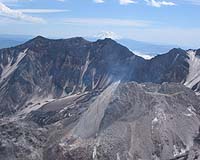| . |  |
. |
Legaspi, Philippines (AFP) Dec 15, 2009 Tens of thousands of villagers in the Philippines fled their homes on Tuesday as one of the nation's most active volcanoes spewed lava and sent ash plumes high into the sky, authorities said. Soldiers and police marshalled the evacuation from the so-called "danger zone" around the foothills of Mayon volcano, amid concerns a big eruption could occur at any moment. "After the series of ash puffs and ash explosions of 1,000 metres (high), we cannot rule out a major explosion," Cedric Daep, the head of the disaster relief operations in the eastern Bicol region, told reporters. Daep said the authorities aimed to evacuate nearly 50,000 people from villages within eight kilometres (five miles) of the volcano by Thursday. The Philippine Institute of Volcanology and Seismology raised the alert level for Mayon to three on Monday after lava was seen dripping from the crater, and evacuations began immediately. Level three means an eruption is likely in the very near future. The scale runs from one to five, with five meaning an eruption is occurring. However the volcanology institute also said Mayon could yet calm down without an eruption. Mayon, which sits above a farming area about 330 kilometres (200 miles) southeast of Manila, has erupted 48 times since records began, claiming thousands of lives. After the most recent eruption in August 2006, huge deposits of volcanic ash were left on its slopes. When typhoon Durian hit the same area in December of that year, it caused a landslide of volcanic ash that killed over 1,000 people. In 1814, more than 1,200 people were killed as the lava buried the town of Cagsawa. However the 2,460-metre (8,070-feet) volcano remains a popular tourist attraction, and is famous for its perfect cone. The Philippines is part of the so-called Pacific "Ring of Fire" that is known for its volcanic activity. The Philippine volcanology institute lists 22 active volcanoes in the country. strs/mm/kma/txw
Share This Article With Planet Earth
Related Links Bringing Order To A World Of Disasters When the Earth Quakes A world of storm and tempest
 U.S. to modernize volcano monitoring nets
U.S. to modernize volcano monitoring netsReston, Va. (UPI) Dec 9, 2009 The U. S. Geological Survey says it will allocate $7 million for research by 15 universities and state agencies into modernizing volcano monitoring networks. The USGS, an agency of the Department of the Interior, said the funding will come from the American Recovery and Reinvestment Act and will be used to modernize equipment, produce high-resolution maps of high-threat volcanoes for ... read more |
|
| The content herein, unless otherwise known to be public domain, are Copyright 1995-2009 - SpaceDaily. AFP and UPI Wire Stories are copyright Agence France-Presse and United Press International. ESA Portal Reports are copyright European Space Agency. All NASA sourced material is public domain. Additional copyrights may apply in whole or part to other bona fide parties. Advertising does not imply endorsement,agreement or approval of any opinions, statements or information provided by SpaceDaily on any Web page published or hosted by SpaceDaily. Privacy Statement |